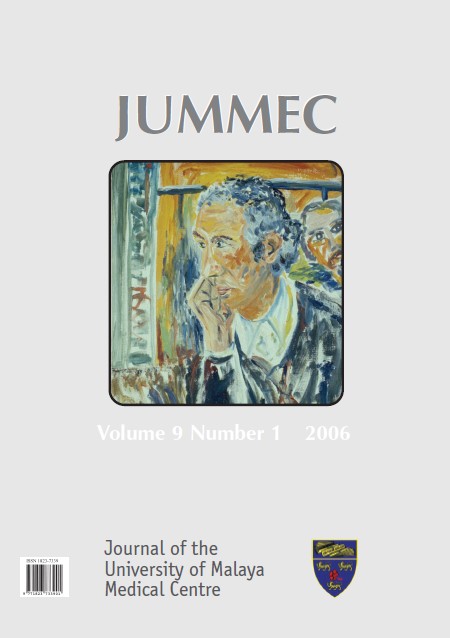PSEUDOMONAS AERUGINOSA: EPIDEMIOLOGY OF BACTEREMIA AND ANTIMICROBIAL SUSCEPTIBILITY PATTERN IN A TEACHING HOSPITAL IN KUALA LUMPUR
Abstract
A cross-sectional study of 109 patients with Pseudomonas aeruginosa
bacteremia from the University of Malaya Medical Centre (UMMC) in the years 2000 and 2001 was conducted to describe epidemiological features, underlying diseases, possible source of infection, early mortality among patients as well as the antibiotic susceptibility pattern of patients' isolates. Further analysis of the 87 patient records that were available revealed that the mean age was 48.5 years (SD ' 25.1). Fifty-two per cent of cases were male and 48% female. Seventy-nine per cent of infections were nosocomially acquired, 33% of bacteremias were polymicrobial, 47% of patients had a continuous bladder drainage catheter (CBD) in situ, 33% had a central venous catheter (CVL) present at the time of bacteremia and 30% were ventilated. Sixty-eight per cent of patients had an underlying immunosuppressed state and 26% had undergone surgery involving general anesthesia in the week prior to isolating P. aeruginosa. Among the 23 patients with early mortality, 61% were on inappropriate antimicrobials. Most of the patients' isolates were sensitive to imipenem (86%), ciprofloxacin (81%), ceftazidime (79%), gentamicin (78%) and cefoperazone (77%). Among the community acquired strains, however, there was 100% sensitivity to imipenem, ceftazidime, cefoperazone and ciprofloxacin.
Downloads
Downloads
Published
Issue
Section
License
All authors agree that the article, if editorially accepted for publication, shall be licensed under the Creative Commons Attribution License 4.0 to allow others to freely access, copy and use research provided the author is correctly attributed, unless otherwise stated. All articles are available online without charge or other barriers to access. However, anyone wishing to reproduce large quantities of an article (250+) should inform the publisher. Any opinion expressed in the articles are those of the authors and do not reflect that of the University of Malaya, 50603 Kuala Lumpur, Malaysia.


